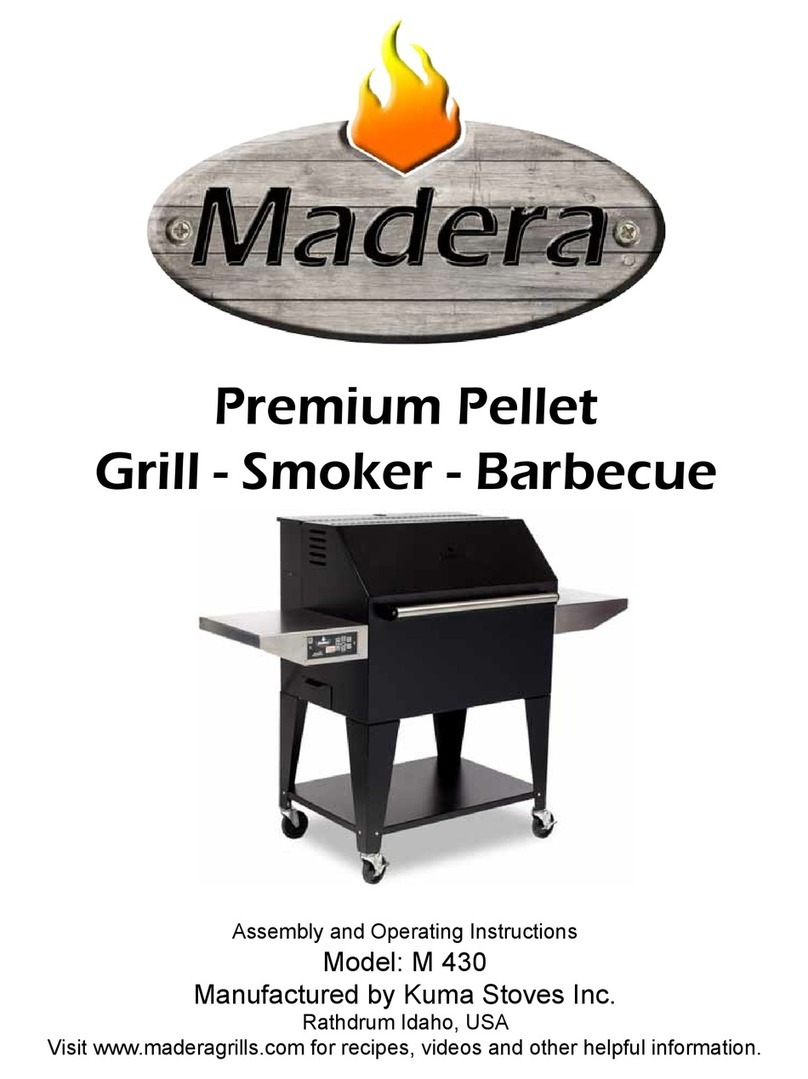
10
ing. But before we get cooking, here are a few
helpful tips to keep your grill looking and working
as fantastic as your food is going to taste:
• Only use premium grade BBQ wood pellets.
Do not use home heating pellets. We recom-
mend Bear MountainTM Premium Hardwood
Cooking Pellets available through you dealer
or at maderagrills.com
• Keep your pellets and your grill dry by always
covering your grill.
• You may cover the sides of the drip tray and
Quick Grill Zone cover with aluminum foil to
make cleaning easier.
• Wipe down your grill with a damp cloth after
each use.
About The Quick Grill Zone Slider
The Quick Grill Zone is used for high temperature
direct grilling and searing over the center grid
of your grill. To use the quick grill zone, simply
slide open the cover by pulling out the handle
located on the right side shelf until it stops. Place
your food on the center of the grill and sear it to
perfection. When grilling on high (480° or FL-3),
the center cooking grid will reach temperatures
over 600°. To close off the quick grill zone and
return to indirect cooking, push the handle back
in until it stops.
About The Adjustable Exhaust Vents
Your grill features adjustable exhaust vents that
can be used to create the perfect cooking envi-
ronment regardless of the weather conditions.
Most of the time you will simply leave both vents
open. On a windy day you can close off one side
of the exhaust to block the wind. On a very cold
day you can partially close both vents to minimize
heat loss. Remember that your grill automati-
cally controls the temperature inside the grill by
adjusting the fuel and combustion air, the adjust-
able vent can simply be used to block excessive
wind or cold weather. CAUTION: Do not touch
the exhaust vents while the grill is running as
they will be extremely hot. If you would like to
adjust the vents while the grill is running, use a
bbq tool or hot mitts.
About Your Digital Controls
Your grill automatically controls the temperature,
smoke, and convection with the push of a button.
When you choose an operating temperature of
300° or below, the grill operates in smoke mode.
In smoke mode you will notice the fan “bellowing”
or coming on and off to control both temperature
and smoke. When you choose an operating
temperature above 300°, the grill operates in grill
mode precisely controlling the temperature of
your grill.
1. Power - This powers on and automatically
lights the grill. When you start your grill this
is always the fi rst button that you push. Push
the button again, at any time to shut down the
grill.
2. Prime - This button manually runs the auger
to prime the feed tube and burn pot. Only use
this button if you are starting your grill for the
fi rst time or if you run the grill out of pellets.
(See section 3 for initial seasoning and prim-
ing your grill).
3. TEMP Arrows - Adjusts the set point temper-
ature up or down.
4. PROBE Button - The PROBE Button toggles
the display between ●Grill and ●Meat. When
the ●Grill indicator light is on: you are display-
ing and controlling the temperature of the grill.
When the ●Meat indicator light is on: you are
displaying and controlling the temperature
settings of the meat probe. Note: You must
plug in your meat probe in order to use the
meat probe feature (see “Understanding
The Meat Probe” later in this section).
5. DISPLAY Button - The DISPLAY Button
toggles the display between ●Actual temper-
ature and ●Set point Temperature. When the
●Actual indicator light is on: the grill is dis-
playing the actual temperature of the selected
probe. When the ●Set point indicator light is
on: the grill is displaying the current set point
for the selected probe.




























